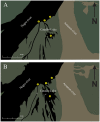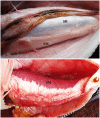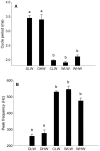Spatiotemporal variability and sound characterization in silver croaker Plagioscion squamosissimus (Sciaenidae) in the Central Amazon
- PMID: 25098347
- PMCID: PMC4123845
- DOI: 10.1371/journal.pone.0099326
Spatiotemporal variability and sound characterization in silver croaker Plagioscion squamosissimus (Sciaenidae) in the Central Amazon
Abstract
Background: The fish family Sciaenidae has numerous species that produce sounds with superfast muscles that vibrate the swimbladder. These muscles form post embryonically and undergo seasonal hypertrophy-atrophy cycles. The family has been the focus of numerous passive acoustic studies to localize spatial and temporal occurrence of spawning aggregations. Fishes produce disturbance calls when hand-held, and males form aggregations in late afternoon and produce advertisement calls to attract females for mating. Previous studies on five continents have been confined to temperate species. Here we examine the calls of the silver croaker Plagioscion squamosissimus, a freshwater equatorial species, which experiences constant photoperiod, minimal temperature variation but seasonal changes in water depth and color, pH and conductivity.
Methods and principal findings: Dissections indicate that sonic muscles are present exclusively in males and that muscles are thicker and redder during the mating season. Disturbance calls were recorded in hand-held fish during the low-water mating season and high-water period outside of the mating season. Advertisement calls were recorded from wild fish that formed aggregations in both periods but only during the mating season from fish in large cages. Disturbance calls consist of a series of short individual pulses in mature males. Advertisement calls start with single and paired pulses followed by greater amplitude multi-pulse bursts with higher peak frequencies than in disturbance calls. Advertisement-like calls also occur in aggregations during the off season, but bursts are shorter with fewer pulses.
Conclusions and significance: Silver croaker produce complex advertisement calls that vary in amplitude, number of cycles per burst and burst duration of their calls. Unlike temperate sciaenids, which only call during the spawning season, silver croaker produce advertisement calls in both seasons. Sonic muscles are thinner, and bursts are shorter than at the spawning peak, but males still produce complex calls outside of the mating season.
Conflict of interest statement
Figures







References
-
- Connaughton MA, Taylor MH (1995) Seasonal and daily cycles in sound production associated with spawning in the Weakfish, Cynoscion Regalis . Environ Biol Fishes 42: 233–240.
-
- Lagardère J, Mariani A (2006) Spawning sounds in meagre Argyrosomus regius recorded in the Gironde estuary, France. J Fish Biol 69: 697–1708.
-
- Luczkovich J, Mann D, Rountree R (2008) Passive Acoustics as a Tool in Fisheries Science. Trans Am Fish Soc 137: 533–541.
-
- Mok HK, Yu HY, Ueng JP, Wei RC (2009) Characterization of Sounds of the Blackspotted Croaker Protonibea diacanthus (Sciaenidae) and Localization of Its Spawning Sites in Estuarine Coastal Waters of Taiwan. Zool Stud 48: 325–333.
-
- Picciulin M, Calcagno G, Sebastianutto L, Bonacito C, Codarin A, et al. (2012) Diagnostics of nocturnal calls of Sciaena umbra (L., fam. Sciaenidae) in a near shore Mediterranean marine reserve, Bioacoustics. iFirst, 1–12.
Publication types
MeSH terms
LinkOut - more resources
Full Text Sources
Other Literature Sources
Miscellaneous

